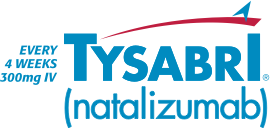5-YEAR RESULTS FROM THE TYSABRI GLOBAL OBSERVATIONAL PROGRAM IN SAFETY (TYGRIS) STUDY1
Study description: TYGRIS was a 5-year, global, observational cohort study designed to capture long-term safety data in patients with MS treated with TYSABRI® (natalizumab). The incidence and pattern of treatment-emergent serious adverse events were examined in a postmarketing sample of 6434 patients who received TYSABRI, 2207 of whom enrolled in the US.
- TYGRIS did not require a fixed-dosing regimen
- No exclusion criteria were applied
- Patients had received 3 or fewer infusions of TYSABRI at the time of enrollment, except for US patients who had completed a prior TYSABRI study and were eligible to enroll if they had received more than 3 TYSABRI infusions
Study limitations:
- Interpret results with caution, as patients in the TYGRIS study were not randomly assigned to natalizumab treatment but chose to switch to TYSABRI and therefore may not be representative of the global MS population
- 24.1% of enrolled patients withdrew from the study, which may have led to selection bias, as patients with side effects are more likely to withdraw, leading to an underestimation of TYSABRI-associated SAEs
- Comorbidities were not assessed in TYGRIS, although the presence of comorbid conditions could affect safety outcomes
- The anti-JCV antibody test was not available when the TYGRIS study was initiated; therefore, TYGRIS was not designed to collect these data, which could have informed the results
Low rates of opportunistic infection and malignancy were found with TYSABRI use in the 5-year TYGRIS study1
INCIDENCE OF SERIOUS OPPORTUNISTIC INFECTIONS
- Overall PML incidence was 0.1% (3 of 2207 patients)
- Overall incidence of non-PML serious opportunistic infections was <0.1% (2 of 2207 patients)
- The malignancy rate for patients in the US study population was 2.0% (49 of 2207 patients)
bPreferred terms; each patient was counted only once within each preferred term.
cTwo patients experienced >1 serious opportunistic infection other than PML: one had aspergilloma and an atypical mycobacterial infection, and the other had cryptococcal fungemia and cryptococcal meningitis.
dThese opportunistic infections were not specified.
The TYGRIS study was funded by Biogen.
